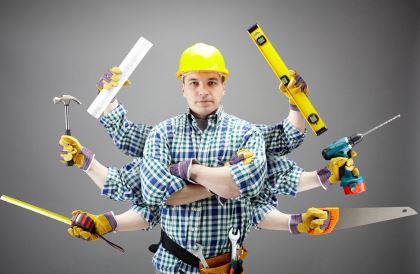<p style="text-align: justify;">There are many benefits to learning how to be your own handyman. Among other things, you can take pride in your accomplishments when the job has been well done as well as save a great deal of money. But there are things that you’ll need to do to avoid injury, especially if you’re handling power tools. Of course, the first things you should do before you even pick up a tool is make sure that it’s sharp and in good shape. Just doing a simple eye check to make sure the tool your using doesn&#8217;t look broken can save you a lot of hurt. You should wear protective gear, and handle the tools the right way. Here are five skills that you&#8217;ll need to learn to avoid injury:</p>
<h2 style="text-align: justify;"><strong>Hammering A Nail</strong></h2>
<p style="text-align: justify;">Starting off with the basics. Hammering a nail is something that all of us have seen happen and so even if we haven&#8217;t indulged in the pleasure that is manual labor, we can still envision ourselves being able to do this task. To hammer a nail, hold the nail near the head and not by the head. If the hammer slips, it won’t crush your fingers. If you’re hitting the nail dead on, watch the nail and not the hammer. The hammer will do the work.</p>
<p style="text-align: justify;"><img class="aligncenter size-full wp-image-11774" src="https://medusamagazine.com/wp-content/uploads/2014/01/Handyman-Skills.jpg" alt="Safety First: Avoid Injury At Home by Learning These 5 Handyman Skills" width="420" height="274" /></p>
<h2 style="text-align: justify;"><strong>Soldering</strong></h2>
<p style="text-align: justify;">Learning to solder can be a very valuable skill to have as it is used in plumbing, electronics and metalwork like jewelry. When soldering with a propane torch or a soldering iron, always protect any flammable objects in the area with sheet metal or something nonflammable. Also, make sure that all joints are clean and fit together well before soldering. Remember, if you can write with a pen or pencil you can solder!</p>
<h2 style="text-align: justify;"><strong>Using A Sabersaw</strong></h2>
<p style="text-align: justify;">A sabersaw is a versatile power tool that can be bought at any reputable tool shop like those found at <span style="color: #000080;"><span style="text-decoration: underline;">http://www.toolsandmachinery.com/bosch-parts-3210/</span></span>. As it’s a power tool, it needs to be handled carefully. If you need it to cut through a heavy gauge metal or thick material, push it slowly and don’t force it. If the motor starts to heat up, run it without a load for a while, then check the sharpness of the blade after it cools. A dull blade makes the motor work too hard. Also, always start the motor before starting to work. If you start the motor with the blade in contact with the material, you’ll break the blade and pieces of it can fly off.</p>
<h2 style="text-align: justify;"><strong>Using a Cold Chisel</strong></h2>
<p style="text-align: justify;">A cold chisel is a tool made of tempered steel used for cutting into &#8216;cold&#8217; metals. It has many applications in everyday DIY life and can be a great ally for home refurnishing projects. If you’re using a cold chisel to remove nuts or bolts, strike it with a baby sledge and not a claw hammer. Make sure you wear gloves to protect the hand that holds the chisel. Don&#8217;t be afraid to show a little force with this one.</p>
<h2 style="text-align: justify;"><strong>Using an Electric Drill</strong></h2>
<p style="text-align: justify;">One of the &#8216;must-haves&#8217; of any respectable DIY&#8217;er and probably the most versatile tool. It can be fitted with different heads or “bits” to fit whichever crew you need to remove or place. Hold the drill securely with both hands and keep it steady and square to the work. If the drill wobbles, the bit will break so make sure to hold it steady. Also, use a slow speed to drill pilot holes and remember that you can always make a hole bigger but you can never make it smaller.</p>
<p style="text-align: justify;">Being proficient with these handyman skills can be extremely valuable in your personal and possibly professional life. These are a few of the tips that should make the job of a DIYer go quickly, easily and safely.</p>

Safety First: Avoid Injury At Home by Learning These 5 Handyman Skills
